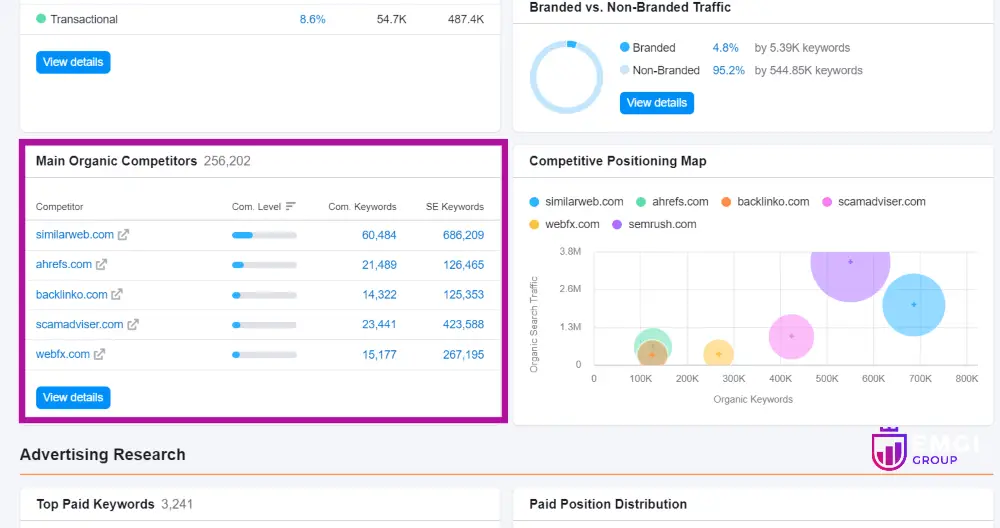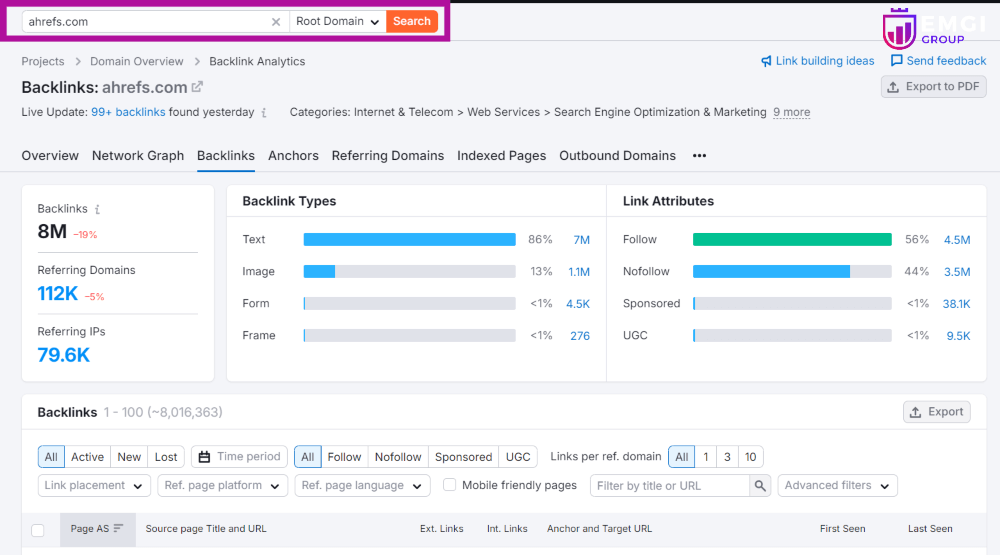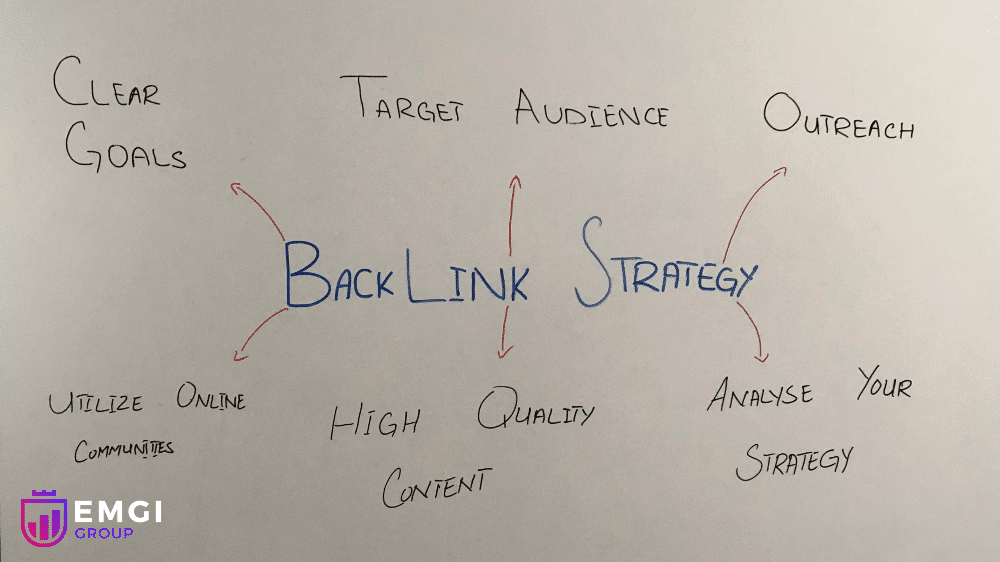
- Last Updated:
SaaS (Software as a Service) Competitor backlink analysis involves evaluating the backlink profiles of competing SaaS providers to gain insights into their link-building strategies and identify opportunities for acquiring similar links. Competitor backlink analysis helps SaaS companies improve their SEO efforts by understanding which backlinks contribute most to their competitors’ domain authority and overall search engine rankings.
To perform a competitor link analysis, identify top competitors, gather competitor backlinks data, analyze backlink profiles, identify high-quality backlinks, find link gaps, and create a link-building strategy for your SaaS website. To build your own backlink strategy after competitors’ backlinks analysis, set clear goals, identify target audience and keywords, create high-quality, link-worthy content, identify potential link sources, utilize social media and online communities, monitor your backlink profile, and analyze and adjust your strategy.
The challenges of competitor backup analysis involve data volume, spammy links, resource intensity, and technical expertise. The best competitor backlink analysis tools involve Semrush Backlink Analytics, Ahrefs Backlink Checker, Ubersuggest (Neil Patel’s Backlink Checker), Rankwatch Backlink Checker, and Seo Review Tools Backlink Checker.
This ultimate guide to SaaS competitor backlink analysis provides in-depth insights to perform competitors’ analysis, build your backlink strategy, resolve the challenges of competitors’ backlink analysis with the best tools, and many more.
Table of Contents
ToggleWhat Is Competitor Backlink Analysis?
Competitor backlink analysis is the process of examining the backlinks that point to your competitors’ websites to gain insights into their link-building strategies. By identifying the sources of their backlinks, you discover new opportunities for your SaaS website to improve its search engine rankings.
Conducting a competitor backlink analysis provides a roadmap for your SEO efforts. By identifying high-quality sites that link to your competitors, you target these sites for your link-building outreach. Additionally, understanding the content types and topics that attract backlinks in your niche helps you create more link-worthy content.
We’re going to use Semrush for the analysis. Semrush provides detailed data and tools for backlink and link profile analysis, allowing you to effectively track and evaluate competitors’ backlinks. Using Semrush, you uncover high-quality link opportunities, identify authoritative sites linking to your competitors, and understand patterns in your industry.
How Competitors’ Backlink Analysis Help in SaaS Link Building Strategy?
Competitor backlink analysis helps in link-building strategy by offering link-building opportunities, helping understand competitors’ link-building strategies, helping evaluate your performance, providing high-quality backlink opportunities, revealing new content ideas, and uncovering link gaps.
Competitor backlink analysis also provides insights into the anchor texts used in your competitors’ backlinks. Understanding the keywords and phrases that are commonly used helps you optimize your anchor text strategy, making it more effective in improving your site’s search engine rankings.
Following are the ways competitors’ link analysis help in building a backlink strategy for SaaS website:
- Offers Link-Building Opportunities
Competitor backlink analysis helps you find websites that link to your competitors and gives you ideas for where you try to get backlinks which improve your website’s authority and search engine ranking.
- Helps Understand Competitor’s Link Building Strategies
Understanding your competitors’ link-building strategies involves analyzing their backlink profiles to see where they are getting their links and helps you identify their tactics and sources, giving you insights into effective strategies.
- Helps Evaluate Your Performance
Competitor backlinks help evaluate your performance by allowing you to compare your link profile with theirs which provides insights into your relative standing in the industry and identifies areas for improvement in your link-building.
- Provides High-Quality Backlinks Opportunity
Competitor backlink analysis provides high-quality backlink opportunities by revealing which sites are linking to your competitors. These sites are likely to be interested in similar content, making them prime targets for your link-building efforts.
- Reveals New Content Ideas
Competitor backlink reveals new content ideas by showing what types of content are attracting links to your competitors helping you understand what topics are popular and inspiring you to create similar or better content to attract more backlinks.
- Uncovers Link Gaps
Uncovering link gaps involves identifying opportunities where competitors have backlinks that you don’t, which helps you spot missing links that could boost your site’s authority and fill in gaps in your link-building efforts.
How to Perform a Competitor Link Analysis?
To perform a competitor’s link analysis by evaluating the domain authority, relevance, and trustworthiness of the linking sites. Focus on identifying high-quality links from authoritative and relevant domains, as these are the most valuable for SEO. Look for patterns in the anchor texts used by your competitors to understand how they are optimizing their backlink profiles. Additionally, identify any broken links or opportunities for guest posting on the sites that link to your competitors. These are potential targets for your link-building efforts.
Following are the ways to perform a competitor link analysis:
Identify Top Competitors
To begin a competitor link analysis, it’s essential to identify your top competitors which ensures you analyze and benchmark your backlink profile against the most relevant and competitive domains in your industry.
Start by logging into your SEMrush account and navigating to the “Competitive Research Toolkit” section. From there, access the “Domain Overview” tool, where you enter your domain name and click “Search.” Once the report is generated, scroll down to the “Main Organic Competitors” section. The section will display a list of domains that compete with yours in organic search results, typically websites that rank for similar keywords. Review the list of competitors, focusing on those with a high number of common keywords and significant traffic metrics.
The following image shows how to identify main organic competitors through semrush:

Additionally, use the “Backlink Analytics” tool by entering the competitor’s domain to review their backlinks, referring domains, and anchor texts. For a more comprehensive comparison, utilize the “Backlink Gap” tool. Enter your domain and those of your identified top competitors to see where they are getting backlinks that you might be missing.
Gather Competitor Backlink Data
Once you’ve identified your top competitors, the next step is to gather their backlink data to analyze their link-building strategies. Start by using SEMrush’s “Backlink Analytics” tool. Enter a competitor’s domain in the search bar to generate a comprehensive backlink profile which provides detailed information on the total number of backlinks, referring domains, domain authority, and the types of backlinks (such as text, image, or form).
Review the referring domains to identify high-authority websites linking to your competitors. SEMrush also provides metrics like the authority score of each referring domain, which helps you prioritize the most valuable backlinks. Examine the anchor texts used in these backlinks to understand how competitors are optimizing their links for relevant keywords.
The following image shows how to gather competitor backlink data:

Next, use the “Backlink Gap” tool in SEMrush to compare your backlink profile with those of your competitors and the tool highlights the unique backlinks your competitors have that your site lacks, allowing you to identify potential link-building opportunities. Additionally, analyze the top pages that are attracting the most backlinks on your competitors’ websites which provide insights into the types of content that are most effective for earning backlinks in your industry.
Analyze Backlink Profiles
Analyzing your competitors’ backlink profiles involves a detailed examination of the backlinks they have acquired, providing insights into their SEO strategies and opportunities for your link-building efforts.
Use the “Backlink Gap” tool to compare your backlink profile with your competitors’. The tool highlights unique backlinks your competitors have that you don’t, revealing potential link-building opportunities. Export the data for further analysis, focusing on high-authority domains and successful content types.
To analyze backlink profiles using SEMrush, first, log in to your SEMrush account and navigate to the “Backlink Analytics” tool found in the SEO Toolkit section. Enter the domain you want to analyze into the search bar and click “Search.” SEMrush will provide an overview of the backlink profile, including metrics such as the total number of backlinks, referring domains, and the ratio of new versus lost backlinks.
The following image shows how to analyze backlink profiles on semrush:

From there, you delve deeper into the “Backlinks” tab to view detailed information on each backlink, including the referring domain and anchor text. The “Referring Domains” tab allows you to assess the quality and relevance of the domains linking to your site, while the “Anchors” tab provides insight into the anchor text used in these links. Additionally, use the “Backlink Gap” tool to compare your backlink profile with competitors and identify new link-building opportunities.
Identify High-Quality Backlinks
To identify high-quality backlinks in your competitors’ profiles, start by focusing on links from authoritative and relevant websites. High-quality backlinks typically originate from domains with high domain authority, indicating that these sites are well-regarded by search engines. These links often come from websites that produce credible, in-depth content such as research papers, industry reports, or respected blogs within your niche.
Additionally, it’s important to assess the context of the backlinks. Links that are naturally integrated into valuable content, like comprehensive articles or expert roundups, tend to hold more weight. Analyzing the anchor text used in these backlinks also provides insights into the relevance and quality of the links. Anchor texts that are contextually related to the content on both the linking and the target pages indicate a higher-quality link.
Using tools like Semrush, you delve deeper into your competitors’ backlink profiles. Semrush allows you to filter backlinks based on domain authority, traffic, and relevance, making it easier to pinpoint which links are contributing the most to your competitors’ SEO success.
Find Link Gaps
Finding link gaps involves identifying high-quality backlinks your competitors have that your site lacks. By pointing these gaps, you discover valuable linking opportunities that enhance your website’s SEO performance.
Finding link gaps in the context of competitor link analysis involves identifying high-quality backlinks your competitors have that your site lacks. It is very important for uncovering valuable linking opportunities that significantly enhance your website’s SEO performance. Using tools like Semrush, you perform a comprehensive comparison of your backlink profile against those of your competitors. These tools highlight specific links that benefit your competitors but are missing from your profile.
After identifying these link gaps, you prioritize your outreach efforts to these high-quality sites and the targeted approach aims to secure backlinks from authoritative domains that are already linking to your competitors. By effectively closing these link gaps, you enhance your site’s authority and relevance, which in turn boosts your overall search engine ranking and visibility.
Create a Link-Building Strategy
Creating an effective link-building strategy involves several key steps:
- Define Objectives: Set clear goals for your link-building efforts, such as enhancing search engine rankings, increasing domain authority, or driving targeted traffic.
- Conduct Competitor Analysis: Analyze your competitors’ backlink profiles using tools like SEMrush. Identify high-quality links they have acquired and the strategies they used.
- Identify Target Sites: Create a list of authoritative and relevant websites for potential link placements. Focus on sites within your industry or niche that have strong domain authority.
- Develop Valuable Content: Produce high-quality content that is likely to attract backlinks. It could be blog posts, infographics, or research reports that offer valuable insights to your target audience.
- Outreach and Collaboration: Reach out to website owners, bloggers, and influencers. Propose collaborations, guest posts, or content-sharing opportunities to earn backlinks from their sites.
- Monitor and Adjust: Regularly track your link-building progress using SEO tools. Evaluate the quality of acquired backlinks and make necessary adjustments to your strategy based on performance metrics and competitive changes.
How to Build Your Own Backlink Strategy After Competitors’ Backlinks Analysis?
Building an effective backlink strategy requires a structured approach that focuses on quality over quantity and aligns with your overall SEO goals. Start by analyzing your competitors’ backlink profiles using tools like Semrush to identify the high-quality backlinks they have secured. Identify link gaps and backlinks your competitors have that your site lacks. These gaps present opportunities for you to reach out to the same authoritative sites and request backlinks.
The following image shows how to build backlink strategy:

Building your backlink strategy after analyzing competitors’ backlinks involves setting clear Goals, identifying the target audience and keywords, creating High-Quality, optimizing on-page SEO, identifying potential link sources, engaging in outreach, leveraging existing relationships, utilizing social media and online Communities, monitoring your backlink profile, analyzing and adjust your strategy.
Following are the ways to build your own backlink strategy after competitors’ backlink analysis:
Set Clear Goals
Setting clear goals is the first and most important step in building an effective backlink strategy. Begin by defining what you aim to achieve with your backlink efforts, such as increasing domain authority, improving search engine rankings, or driving more targeted traffic to your site.
Use tools like Semrush to analyze your competitors’ backlinks, uncovering opportunities and gaps that you target. With well-defined goals and a comprehensive link analysis, you create a focused and effective strategy that drives measurable results.
Identify Target Audience and Keywords
Identifying your target audience and relevant keywords is essential for creating content that attracts quality backlinks. Understanding who your audience is and what they are searching for allows you to tailor your content to meet their needs and interests, increasing the likelihood of earning backlinks.
The keywords that are driving traffic to your competitors conduct a thorough backlinks analysis which helps you identify gaps and opportunities in your strategy. By targeting the right audience and using relevant keywords, you create high-quality content that naturally attracts backlinks, and enhance search engine ranking.
Create High-Quality, Link-Worthy Content
Creating high-quality, link-worthy content is important for attracting backlinks and improving your SEO. Link-building strategy thrives on content that is informative, engaging, and valuable to your audience, making other websites more likely to link to it. Focus on producing in-depth articles, infographics, and unique insights that stand out in your niche.
In addition to quality, ensure your content is optimized for SEO. Use relevant keywords naturally throughout the text, especially in titles, headers, and meta descriptions. Structure your content with clear headings and subheadings to improve readability and make it easier for search engines to index. Include internal and external links to provide additional value to your readers and enhance your content’s credibility.
Identify Potential Link Sources with Backlink Audit
Identifying potential link sources is a critical step in building a robust backlink profile. Start by conducting a thorough link audit of your competitors to uncover where their high-quality backlinks are coming from. Use the information to develop your own backlinks strategy, focusing on reaching out to authoritative sites within your niche.
Additionally, focus on industry-related blogs, news sites, and forums that publish content relevant to your niche. Websites that regularly feature industry news, insights, and guest posts are excellent targets for outreach. Look for opportunities to contribute guest posts, infographics, or expert opinions to these platforms, offering valuable content in exchange for a backlink.
Engage in Outreach
Effective outreach is crucial for securing high-quality backlinks and building strong relationships within your industry. Start by identifying relevant websites, blogs, and influencers that align with your niche and have high domain authority. Personalize your outreach for backlinks by crafting tailored messages highlighting your content’s value and how it benefits your audience.
Utilize email outreach as a primary method, but also engage through social media platforms to build rapport and increase your chances of a positive response. Be genuine and professional in your communication, clearly explaining why linking to your content would be advantageous for their site.
Leverage Existing Relationships
Leveraging existing relationships is a strategic and often overlooked method for building high-quality backlinks. Start by identifying your current network of business contacts, industry partners, satisfied customers, and even personal acquaintances who have websites or blogs relevant to your niche. Reach out to these connections with personalized requests, offering mutually beneficial opportunities such as guest posts, collaborations, or simply asking for a backlink to relevant content on your site.
Utilize Social Media and Online Communities
Utilizing social media and online communities significantly boosts your link-building efforts. Utilize social media platforms such as Facebook, Twitter, LinkedIn, and Instagram to share high-quality content from your website. Engaging in relevant online communities and forums, such as Reddit, Quora, or niche-specific groups, allows you to share your expertise and link to your content where appropriate.
Moreover, actively participating in discussions and providing valuable insights attract attention to your content, leading to more shares and backlinks. Utilize social media analytics tools to monitor the performance of your content and understand which pieces are generating the most engagement and backlinks.
Monitor Your Backlink Profile
Regularly monitoring your backlink profile is crucial for maintaining a healthy link strategy and improving your SEO efforts. Monitoring backlinks allows you to track the quality and quantity of links pointing to your site, ensuring that you maintain a robust and credible backlink profile.
Additionally, by keeping an eye on your backlink profile, you capitalize on successful strategies by replicating the content and outreach efforts that earn high-quality links which ensures that your link-building efforts are aligned with best practices, ultimately enhancing your website’s visibility, authority, and organic traffic.
Analyze and Adjust Your Strategy
Regular analysis and adjustment of your backlink strategy are crucial to ensure its ongoing effectiveness and alignment with your SEO goals. Begin by using tools like SEMrush, Ahrefs, or Moz to conduct a comprehensive link analysis of your current backlink profile, tracking new, lost, and existing links.
Identify patterns and trends in your backlink acquisition, noting which types of content and outreach methods are most successful. Regularly updating your strategy also involves disavowing harmful or low-quality backlinks that could negatively impact your site’s ranking. Staying informed about search engine algorithm updates and best practices is essential to adapt your link-building approach accordingly.
What Are the Challenges of a Competitor Backlink Analysis?
The challenges of a competitor backlink analysis include data volume, data quantity, tool limitation, dynamic nature, spammy links, resource intensity, link value, and technical expertise.
Conducting a competitor backlink analysis provides valuable insights, but it also comes with several challenges. One major difficulty is accessing comprehensive and accurate data, as some backlinks may be hidden or not fully visible through standard tools. Another challenge is interpreting the quality and relevance of backlinks, which requires a nuanced understanding of how these links impact SEO.
The details of the challenges of competitor backlink analysis are given below:
Dealing with Huge Data Volume
Dealing with a large volume of backlinks to analyze, it’s crucial to prioritize and filter the data effectively. Focus on high-quality backlinks from authoritative domains, and use Semrush’s filtering options to sort by metrics such as domain authority, anchor text, and toxicity score.
Risk of Low Data Quality
Inaccurate or outdated backlink data mislead your analysis, affecting your SEO decisions. Regularly updating and verifying backlink data ensures accurate insights and helps maintain an effective link-building strategy.
Tool Limitations
Tool limitations in backlink analysis, such as restricted features or coverage, hinder comprehensive insights. It’s essential to be aware of these constraints and consider using multiple tools or methodologies to fill any gaps in your analysis.
Dynamic Nature of Links
The dynamic nature of backlinks means they are constantly changing, making it challenging to track updates and maintain an accurate profile. Regular monitoring and real-time alerts are essential to stay informed of new, lost, or altered backlinks.
Risk of Spammy Links
Identifying and filtering out low-quality or spammy backlinks is important to prevent potential penalties and maintain a healthy backlink profile. Use SEMrush’s toxic score feature to detect and disavow harmful links that could negatively impact your site’s SEO.
Difficulty in Context & Relevance Evaluation
Understanding the context and relevance of backlinks involves analyzing whether the links are naturally integrated within high-quality, relevant content which helps ensure that backlinks positively influence your SEO by aligning with your site’s niche and audience.
Concerning Competitor Secrecy
Competitor secrecy, where hidden or private backlinks are not easily discoverable, limits the completeness of your backlink analysis. Using tools like SEMrush’s comprehensive database and competitor research features helps to uncover hidden backlinks.
Resource Intensity
Backlink analysis is resource-intensive, often requiring considerable time and effort to collect, filter, and interpret data accurately. Utilizing automated tools like SEMrush streamlines the process.
Determining Link Value
Determining the true value and impact of each backlink involves assessing factors such as the linking site’s authority, relevance to your content, and the quality of the link placement.
Lacking Technical Expertise
Backlink analysis requires specialized knowledge and technical skills to effectively interpret complex data, understand SEO metrics, and apply findings to improve site performance.
What Are the Best Competitor Backlink Analysis Tools?
The best competitor backlink analysis tools are SEMrush backlink analytics, Ahrefs backlink checker, Moz link explorer, Uber suggest( Neil Patel’s backlink checker, Open link profiler, Small Seo tools backlink checker, Rankwatch backlink checker, and Seo review tools backlink checker.
Competitor backlink analysis tools are essential for understanding how competitors acquire their backlinks and for identifying opportunities to improve your link-building strategy. Each tool offers unique features to help you analyze your competitors’ link profiles and gain valuable insights.
Following are the competitor backlink analysis tools:
Semrush Backlink Analytics
Semrush Backlink Analytics provides a comprehensive overview of your competitors’ backlink profiles, offering insights into their link-building strategies. It helps identify high-quality links and track new and lost backlinks.
Ahrefs Backlink Checker
Ahrefs Backlink Checker is a powerful tool that offers detailed insights into your competitors’ backlink profiles. It provides data on the number of backlinks, referring domains, and the quality of these links.
Moz Link Explorer
Moz Link Explorer is a comprehensive tool for analyzing backlink profiles and domain authority. It provides insights into the quantity and quality of backlinks, identifies top linking domains, and evaluates the overall link strength of websites.
Ubersuggest (Backlink Checker)
Ubersuggest is a versatile SEO tool that includes a backlink checker among its features. It helps users analyze backlink profiles by providing insights into the quantity and quality of backlinks, identifying referring domains, and evaluating link strength.
Openlinkprofiler
OpenLinkProfiler is a free tool designed for analyzing backlinks. It provides detailed information on the backlinks pointing to a website, including metrics such as the number of links, their quality, and the link distribution across domains.
Small Seo Tools Backlink Checker
The Small SEO Tools Backlink Checker is a free tool that allows users to examine the backlinks pointing to their website. It helps identify both positive and potentially harmful links, enabling users to refine their link-building strategies.
Rankwatch Backlink Checker
The Rankwatch Backlink Checker is a tool designed to analyze the backlinks of a website, offering insights into the quality and quantity of links pointing to it. It provides detailed reports on link sources, anchor texts, and the overall health of the backlink profile.
Seo Review Tools Backlink Checker
The SEO Review Tools Backlink Checker is a tool that evaluates the backlinks pointing to a website. It provides a comprehensive overview of the backlink profile, including details about the source domains, anchor texts, and the quality of the links.
Relevant Content
HARO Link Building Become the Go-To Expert in Your Industry Strategic HARO outreach that positions you as an industry authority while securing high-DR editorial links from top publications. Schedule a Call Expert Responses Professionally crafted responses to journalists High-DR Publications
Ecommerce Link Building Drive More Sales Through Strategic Links Specialized link building for ecommerce brands. Product placements, category pages, and brand authority links that drive both traffic and sales. Schedule a Call Sales-Focused Links that drive actual product sales Category
SaaS Link Building Dominate SaaS Search Results Strategic link building for SaaS companies. High-authority and mega contextual links from tech industry blogs, SaaS companies and even the unicorns. We landed links on Zoom, Hubspot and BigCommerce for multiple clients. Schedule
Scalable rankings, traffic, authority & REVENUE Backlinks that FUEL Silly Growth Results within 45 days, NOT 18 months Schedule a Call Why Choose EMGI Group? We’re authoritative, but trying new things. Modern and tech-first, not stuck in the old ways.